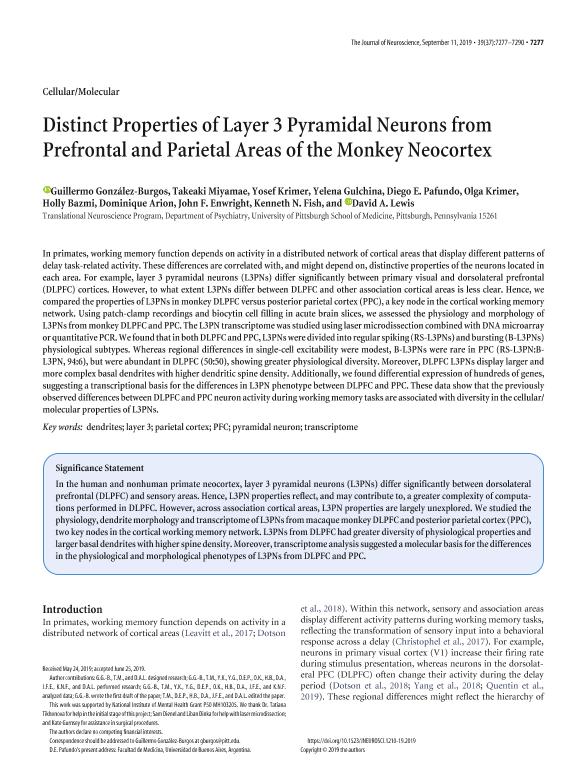Mostrar el registro sencillo del ítem
dc.contributor.author
Gonzalez Burgos, Guillermo

dc.contributor.author
Miyamae, Takeaki
dc.contributor.author
Krimer, Yosef
dc.contributor.author
Gulchina, Yelena
dc.contributor.author
Pafundo, Diego Esteban

dc.contributor.author
Krimer, Olga
dc.contributor.author
Bazmi, Holly
dc.contributor.author
Arion, Dominique
dc.contributor.author
Enwright, John F.
dc.contributor.author
Fish, Kenneth N.
dc.contributor.author
Lewis, David A.
dc.date.available
2020-12-17T12:51:38Z
dc.date.issued
2019-07
dc.identifier.citation
Gonzalez Burgos, Guillermo; Miyamae, Takeaki; Krimer, Yosef; Gulchina, Yelena; Pafundo, Diego Esteban; et al.; Distinct properties of layer 3 pyramidal neurons from prefrontal and parietal areas of the monkey neocortex; Society for Neuroscience; Journal of Neuroscience; 39; 37; 7-2019; 7277-7290
dc.identifier.issn
0270-6474
dc.identifier.uri
http://hdl.handle.net/11336/120712
dc.description.abstract
In primates, working memory function depends on activity in a distributed network of cortical areas that display different patterns of delay task-related activity. These differences are correlated with, and might depend on, distinctive properties of the neurons located in each area. For example, layer 3 pyramidal neurons (L3PNs) differ significantly between primary visual and dorsolateral prefrontal (DLPFC) cortices. However, to what extent L3PNs differ between DLPFC and other association cortical areas is less clear. Hence, we compared the properties of L3PNs in monkey DLPFC versus posterior parietal cortex (PPC), a key node in the cortical working memory network. Using patch-clamp recordings and biocytin cell filling in acute brain slices, we assessed the physiology and morphology of L3PNs from monkey DLPFC and PPC. The L3PN transcriptome was studied using laser microdissection combined with DNA microarray or quantitative PCR. We found that in both DLPFC and PPC, L3PNs were divided into regular spiking (RS-L3PNs) and bursting (B-L3PNs) physiological subtypes. Whereas regional differences in single-cell excitability were modest, B-L3PNs were rare in PPC (RS-L3PN:BL3PN, 94:6), but were abundant in DLPFC (50:50), showing greater physiological diversity. Moreover, DLPFC L3PNs display larger and more complex basal dendrites with higher dendritic spine density. Additionally, we found differential expression of hundreds of genes, suggesting a transcriptional basis for the differences in L3PN phenotype between DLPFC and PPC. These data show that the previously observed differences between DLPFC and PPC neuron activity during working memory tasks are associated with diversity in the cellular/ molecular properties of L3PNs.
dc.format
application/pdf
dc.language.iso
eng
dc.publisher
Society for Neuroscience

dc.rights
info:eu-repo/semantics/openAccess
dc.rights.uri
https://creativecommons.org/licenses/by-nc-sa/2.5/ar/
dc.subject
DENDRITES
dc.subject
LAYER 3
dc.subject
PARIETAL CORTEX
dc.subject
PFC
dc.subject
PYRAMIDAL NEURON
dc.subject
TRANSCRIPTOME
dc.subject.classification
Neurociencias

dc.subject.classification
Medicina Básica

dc.subject.classification
CIENCIAS MÉDICAS Y DE LA SALUD

dc.title
Distinct properties of layer 3 pyramidal neurons from prefrontal and parietal areas of the monkey neocortex
dc.type
info:eu-repo/semantics/article
dc.type
info:ar-repo/semantics/artículo
dc.type
info:eu-repo/semantics/publishedVersion
dc.date.updated
2020-11-19T21:36:51Z
dc.journal.volume
39
dc.journal.number
37
dc.journal.pagination
7277-7290
dc.journal.pais
Estados Unidos

dc.journal.ciudad
Washington
dc.description.fil
Fil: Gonzalez Burgos, Guillermo. Univeristy of Pittsburgh. School of Medicine; Estados Unidos
dc.description.fil
Fil: Miyamae, Takeaki. Univeristy of Pittsburgh. School of Medicine; Estados Unidos
dc.description.fil
Fil: Krimer, Yosef. Univeristy of Pittsburgh. School of Medicine; Estados Unidos
dc.description.fil
Fil: Gulchina, Yelena. Univeristy of Pittsburgh. School of Medicine; Estados Unidos
dc.description.fil
Fil: Pafundo, Diego Esteban. Consejo Nacional de Investigaciones Científicas y Técnicas. Oficina de Coordinación Administrativa Houssay. Instituto de Fisiología y Biofísica Bernardo Houssay. Universidad de Buenos Aires. Facultad de Medicina. Instituto de Fisiología y Biofísica Bernardo Houssay; Argentina
dc.description.fil
Fil: Krimer, Olga. Univeristy of Pittsburgh. School of Medicine; Estados Unidos
dc.description.fil
Fil: Bazmi, Holly. Univeristy of Pittsburgh. School of Medicine; Estados Unidos
dc.description.fil
Fil: Arion, Dominique. Univeristy of Pittsburgh. School of Medicine; Estados Unidos
dc.description.fil
Fil: Enwright, John F.. Univeristy of Pittsburgh. School of Medicine; Estados Unidos
dc.description.fil
Fil: Fish, Kenneth N.. Univeristy of Pittsburgh. School of Medicine; Estados Unidos
dc.description.fil
Fil: Lewis, David A.. Univeristy of Pittsburgh. School of Medicine; Estados Unidos
dc.journal.title
Journal of Neuroscience

dc.relation.alternativeid
info:eu-repo/semantics/altIdentifier/url/https://www.jneurosci.org/content/early/2019/07/24/JNEUROSCI.1210-19.2019.long
dc.relation.alternativeid
info:eu-repo/semantics/altIdentifier/doi/http://dx.doi.org/10.1523/JNEUROSCI.1210-19.2019
Archivos asociados
